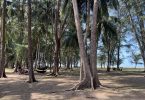Less than a week after Typhoon Nangka brought flooding rain to southern Japan, another tropical threat looms for the nation with the Ryukyu Islands set to face the worst of Typhoon Halola.
Halola continues its long journey across the Pacific Ocean since developing southwest of Hawaii on July 10. That journey will end by early next week in the Sea of Japan, but not before Halola impacts Japan and southeastern South Korea this weekend.
“Halola could become the first tropical cyclone to originate in the central Pacific Ocean and make landfall in Japan since Super Typhoon Oliwa in September 1997,” stated AccuWeather Meteorologist Eric Leister. “Oliwa made landfall with its strength equal to that of a Category 1 hurricane.”
Halola will be a minimal typhoon or will weaken to a tropical storm when it passes through the Ryukyu Islands to start this weekend. Halola prolonging its westward track before a turn to the north has shifted the danger of a direct landfall from Shikoku and Honshu to the Ryukyu Islands.
A track in between or over the islands of Amami and Okinawa is expected Saturday morning, local time with conditions deteriorating Friday night.
Damaging wind gusts of around 130 kph (80 mph) will howl near the center of Halola, while 100 to 200 mm (4 to 8 inches) of rain severely heightens the concern for flash flooding. The heaviest rain will actually be displaced to the south of Halola’s center, meaning the rain could graze Okinawa even if the eye of Halola crosses Amami.
Weather Outlook for Asia
Dangerous surf will build throughout the Ryukyu Islands leading up to this weekend. The threat of an inundating storm surge also exists, especially near and northeast of the typhoon’s center.
After lashing the Ryukyu Islands, Halola will turn to the north and track toward the Sea of Japan. The good news is that disruptive winds aloft, known as wind shear, and cooler waters will force Halola to weaken and lessen the dangers for mainland Japan and southeastern South Korea.
Residents should not totally let their guard down as locally damaging winds and flooding rain still threaten to graze western Kyushu and southeastern South Korea later in the weekend. The eastern East China Sea will also become very rough and dangerous for those with boating interests. Coastal flooding may occur east of where Halola tracks.
“The impacts [from Halola later this weekend] will equate to a strong non-tropical system,” stated AccuWeather Meteorologist Rob Richards.
Halola is expected to weaken further and lose its tropical characteristics by early next week in the Sea of Japan. It may then combine with another system to spread downpours to Hokkaido.






















